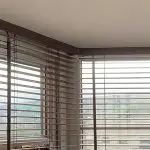The DIY Fix is reader supported. When you buy after clicking a link on our site, we may earn an affiliate commission.
In this article we will be looking at how you can stop damp in your wardrobe. This will include how the damp usually forms. As well as the differences between damp in a fitted wardrobe and damp in a free standing wardrobe.
There are a few things you can do to stop damp in a wardrobe. The first thing you will need to do is improve air circulation and ventilation. This will allow air to circulate inside the wardrobe and avoid condensation forming.
The second thing you can do, is trying to avoid high levels of humidity in the room. Again, this will come down to ventilation and allowing air to circulate throughout the room.

The main reason that wardrobes become damp, is the air is unable to circulate. This means that moist air becomes trapped and settles on the inside surfaces of your wardrobe. This causes damp and will eventually lead to mould forming.
fitted wardrobe or free standing wardrobe
How you deal with the damp in your wardrobe, will depend on the type of wardrobe you have. Are your wardrobes fitted? Or are they free standing wardrobes that you can easily move?
Both types of wardrobe can suffer from poor circulation and ventilation. Because of this, both types can suffer from condensation and moist air being trapped inside the wardrobe. However, fitted wardrobes may cause more problems than free standing wardrobes. This is mainly because a free standing wardrobe can be moved, whereas fitted wardrobes are fixed in place.
One of the most common ways that condensation forms, is when moisture meets a dew point. A dew point is a cold surface that naturally attracts warm moist air. For this reason, you should check whether your wardrobe is placed up against a cold external wall.
if you own a free standing wardrobe this can be easily moved away from cold exterior walls. On the other hand, if your wardrobes are fitted on a cold wall this could be more problematic.
Easy fixes for a free standing wardrobe
If you have a free standing wardrobe, you will often find that you get damp and mould on the back inside surface.
You may also notice the damp and mould begins to form behind your wardrobe. You can easily stop the latter, by slightly moving your wardrobe away from the wall. This will allow air to circulate better, which will mean there is less chance of condensation settling on the wall.
Also, as we mentioned before, if the wardrobe is against a cold exterior wall simply move it to another wall in the room. The combination of a larger gap behind the wardrobe, and being placed on a slightly warmer wall, should stop damp and mould from forming as easily.
What if your fitted wardrobe is on an exterior wall?
If you have a fitted wardrobe on an exterior wall, in most cases you can’t just move it to another wall. your wardrobe is fitted in place and is usually designed for the area is fitted in. However, if it is fitted on a cold exterior wall you will have the same problem. The cold surface will form a dew point, which makes it easier for condensation to form.
Most fitted wardrobes will have a small void between the back of the wardrobe and the wall itself. One solution could be to remove the wardrobes and place insulation behind the back panels. By adding some insulation This should increase the temperature of the back surface, meaning it is no longer a dew point.
You could also consider painting the back wall with an anti mould damp proof paint. This should help to avoid mould forming in the future.
Obviously, you will need to make sure that all mould is removed from the surface. Once this has been done, you can add a coat of anti mould paint and then place insulation. Following this, you can fit your wardrobes back over the newly insulated wall.
Ways to reduce condensation in your wardrobe
As we already know condensation forming is the result of three things:
- Excess moisture and humidity in the air
- Poor ventilation and air circulation
- A cold surface the condensation can form on (a dew point)
As we have already discussed, a cold surface at the back of your wardrobe (also known as a dew point), makes it very easy for condensation to form.
However, for condensation to form there needs to be excess moisture in the air. Therefore, the second thing we need to do is reduce the amount of moisture and humidity in the air.
The best way to reduce moisture in the air is via decent ventilation. This can be achieved in several ways. Firstly, we need to make sure the room itself is well ventilated. This can be as simple as opening a door, or occasionally opening the window. Both actions will allow moist air to escape from the room.
Below are a few more things that you can do to improve circulation, and lower air humidity in your room and wardrobe:
- Use a dehumidifier – A dehumidifier can be a great way of extracting moisture from the air. A good dehumidifier can remove a significant amount of moisture. Larger models can remove as much as eight litres per day. The size of dehumidifier you choose will usually depend on the size of the room that it will be placed in. You can read more about how dehumidifiers reduce damp here
- Regularly open the doors of your wardrobes – Leaving your wardrobe doors closed all the time does not allow any air to circulate inside. By regularly opening them, you will allow trapped moisture to escape and fresh new air to enter the wardrobe.
- Add air vents to your wardrobe – Adding an air vent to your wardrobe is another way you can help air to circulate. This can be beneficial in both fitted and free standing wardrobes.
- Avoid overfilling your wardrobe – Whatever you are putting in your wardrobe, overfilling it is Guaranteed to reduce air circulation. If your wardrobe is packed full of clothes or other items, it will be much easier for damp and mould to form.
- Fully dry clothes – If your wardrobe is mainly for storing clothes, you should make sure that the clothes you place in the wardrobe are completely dry. Adding additional moisture inside your wardrobe in the form of wet clothes, will increase the chance of mould forming.
Conclusion
As we mentioned, the main reason for condensation and damp forming, is moisture in the air and poor ventilation. This will usually result in condensation forming on cold surfaces with poor air circulation.
For this reason, there are things you will need to do, to avoid damp in your wardrobe. Firstly, you need to remove moisture from the air, and secondly you need to improve ventilation and air circulation.
If you can get these things right, damp in your wardrobe should become a thing of the past.




